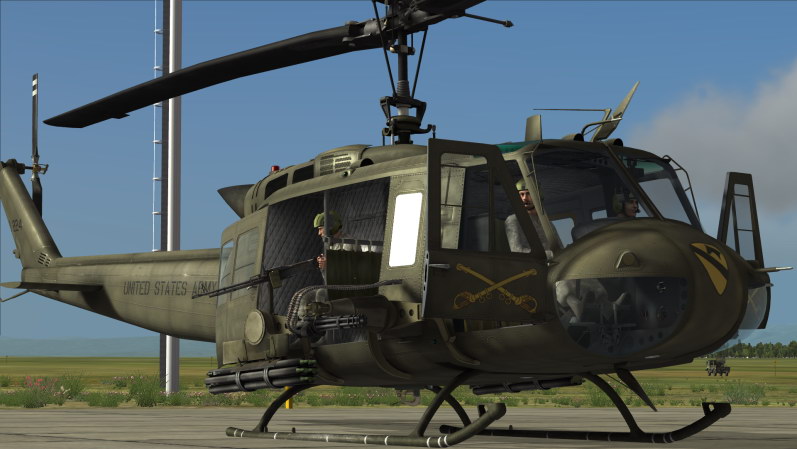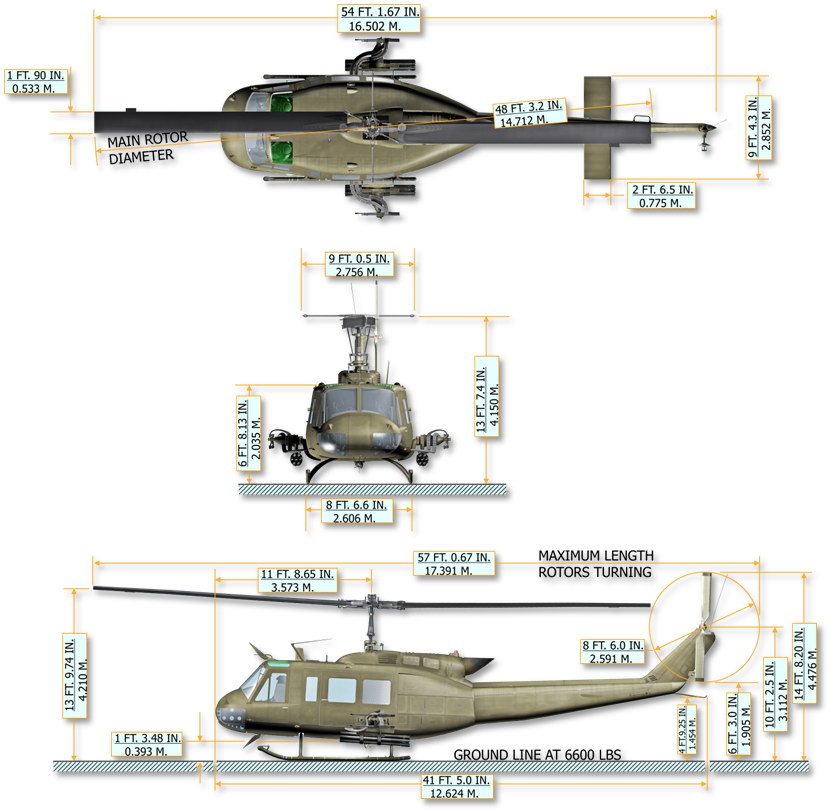El UH-1 "Iroquois" es un helicóptero militar ligero polivalente y utilitario. Más conocido como "Huey" por su denominación original "HU-1", el UH-1 es uno de los helicópteros más emblemáticos del mundo. El Huey, pilar de las fuerzas estadounidenses en la guerra de Vietnam, saltó a la fama tras sus papeles protagonistas en las superproducciones de Hollywood The Deer Hunter (1978) y Apocalypse Now (1979).
Conocido como "slick", la misión principal del Huey era introducir y extraer tropas de combate. Los asaltos aerotransportados en Vietnam solían consistir en hasta 10 slicks que transportaban infantería, con dos o tres helicópteros artillados que proporcionaban protección y un helicóptero de mando y control "Charlie/Charlie" que orbitaba sobre ellos. Las otras misiones del Huey incluían el abastecimiento avanzado, la búsqueda y rescate (SAR), el reconocimiento y la evacuación médica (Medevac) de tropas heridas. El UH-1H puede transportar 4000 libras de armas y carga, incluyendo hasta 14 tropas de combate o 6 camillas. Armado con cohetes y ametralladoras, también puede actuar como cañonero ad hoc.
Desarrollado en la década de 1950, el UH-1 entró en servicio en marzo de 1961. El UH-1H con el motor Lycoming T53-L-13 de 1.400 CV (1.000 kW) es la variante más producida de los más de 16.000 aparatos que se han construido desde entonces. El Huey sigue prestando servicio en todo el mundo, tanto en el ámbito militar como en el civil.
El DCS: UH-1H presenta un modelo actualizado del helicóptero armado con cohetes y ametralladora M134 de seis cañones montados en la puerta. La simulación ofrece un magnífico modelado de vuelo y sistemas. El útil modo Vuelo Fácil y otros modos reducen la curva de aprendizaje para los nuevos jugadores. Las posiciones de los jugadores incluyen piloto, copiloto y artilleros de puerta. Se incluye una campaña hecha a mano, así como una serie de misiones individuales y un curso de formación.
El UH-1, un caballo de batalla robusto y fiable, despierta un enorme afecto entre las antiguas tripulaciones. Cuando lo vueles, entenderás inmediatamente por qué.

The UH-1 Huey is one of the most iconic and recognizable helicopters in the world. Having served extensively as a transport and armed combat support helicopter in the Vietnam War, the Huey continues to perform a wide variety of military and civilian missions around the world today.
"DCS: UH-1H Huey" features an incredible level of modelling depth that reproducers the look, feel, and sound of this legendary helicopter with exquisite detail and accuracy. Developed in close partnership with actual UH-1H operators and experts, the DCS Huey provides the most dynamic and true to life conventional helicopter experience available on the PC.
A variety of realism and gameplay options, a number of single missions and a handcrafted campaign storyline featuring custom voiceovers and characters provide ample fun and immersion for both the realism buff and the casual enthusiast.
"DCS: UH-1H Huey" is the first DCS title to offer multiple player positions, including pilot, co-pilot, and door gunner. The helicopter can be flown as either a lightly armed combat transport or a close air support platform armed with steerable rapid-firing machine guns and unguided rockets.
A comprehensive training course that includes both demonstration lessons and in-cockpit interactive tutorials designed with the help of real helicopter pilots takes you through the learning process of proper helicopter control and employment.
A powerful yet easy-to-use mission editor allows you to create an unlimited number of both single-player and multiplayer missions and campaigns. A one-click Mission Generator also allows you to instantly create battles as small or large as you wish.
Fly online using the built-in server browser and fight with or against other player-controlled DCS aircraft like the Ka-50 Black Shark, P-51D Mustang and A-10C Warthog in a rich multiplayer environment.
Key Features of "DCS: UH-1H Huey" include:
The UH-1H is a single engine, single rotor helicopter. Primary mission capability of the helicopter is air movement of supplies and personnel. Secondary missions include air assault, and command and control (C2) operations under day, night, visual, and instrument conditions.
In DCS: UH-1H Huey, the helicopter can be operated in the following variants:
The helicopter can be employed either from prepared airfields or Forward Area Rearming/Refueling Point (FARP) helipads.
The crew includes the pilot in the right-hand seat, copilot in the left-hand seat and one or two door gunners.

Helicopter velocity is determined using primitive equations that calculate the forces and moments not only at the fuselage center of gravity (CG), but also acting on the turning rotors, which include the flapping motions of the rotor blades. This makes it possible to model all of the dynamic effects specific to helicopter flight.
The aerodynamic forces acting on the helicopter model are derived as a summation of the parameters of its individual elements: main and tail rotors, fuselage, vertical fin, horizontal stabilizer, pylons, landing skids. Each of these elements is positioned and orientated individually within the airframe’s local coordinate system and has its own aerodynamic characteristics.
The aerodynamic characteristics of each model element are pre-calculated with special software using numerical methods. In determining the forces and moments acting on the main and tail rotors, the calculations include the axial and longitudinal components of airflow speed, blade pitch, rotor angular velocities, airflow parameters, and blade inertia characteristics.
The aerodynamic forces acting on each model element are determined according to its pre-calculated characteristics in its own coordinate system. This includes local airflow velocity changes in the vicinity of the element as induced by other model elements.
Each element has a damage/destruction capacity that affects the lifting and center of gravity calculations of the model. Damage can be affected either by aerodynamic force or by physical contact with the ground or other objects. Ground and object contact is modeled using a system of rigid body points.
The detailed, real-time modeling of the dynamics involved with the main and tail rotors, fuselage, empennage, and other elements of the helicopter produces flight characteristics that closely match those of the real Huey and make it possible to naturally induce and closely model important flight conditions and effects like torque-induced yaw, translational lift, translating tendency, rotor overspeed and droop, retreating blade stall, autorotation, settling with power (vortex ring state), etc.
DCS: UH-1H Huey features an accurate and highly detailed 3D model of the helicopter using a 100,000+ polygon construction and a variety of historically accurate and inspired high resolution liveries. Multiple-texture maps, normal maps and specular maps are used to achieve a variety of special effects while extensive use of skeletal animation is made for effects such as rotor blade flexing, skid flexing, and machine gun belt bending.
The main rotor assembly is fully animated and correctly translates movement of the cyclic and collective controls to the rotor system, making it possible to visually see rotor disc tilting, conning, and blade pitching. Tail rotor pitch is animated and correctly translates anti-torque pedal input to the tail rotor.
The model includes extensive damage visualization that includes sector-based bullet/shrapnel penetration, canopy/window fracturing and penetration, and variety of partial or complete tearing of aircraft sections.








